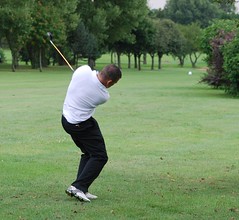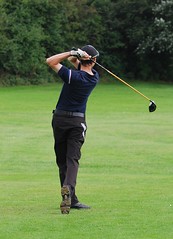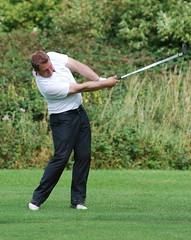 Most golfers might think that there is no more painful condition than a case of the “shanks.” In terms of mental anguish and inner turmoil, I have to agree… it hurts. But if we look at physical, musculoskeletal injuries that plague the game of golf, back pain is the most prevalent and disabling. Both professional and amateur golfers suffer the most from back injuries with 35% of amateur injuries occurring in the low back.1 This isn’t surprising considering what it takes to play golf. Golf is a sport that requires repetitive movement and twisting of the spine in a bent over position, which is very strenuous on the body, especially the lumbar spine, or low back.2 Particularly stressful to the low back is the modern style of swing in which a larger shoulder turn and restricted hip motion in the backswing is advocated. Golf pros call this the “X Factor” or “Coil” in which elastic energy is stored and released to create a more powerful downswing, and hopefully, more distance. Golfers most often get back pain localized the the trail side of the low back and depending on the severity of the injury, you may be out for weeks or your game may be affected long-term.
Most golfers might think that there is no more painful condition than a case of the “shanks.” In terms of mental anguish and inner turmoil, I have to agree… it hurts. But if we look at physical, musculoskeletal injuries that plague the game of golf, back pain is the most prevalent and disabling. Both professional and amateur golfers suffer the most from back injuries with 35% of amateur injuries occurring in the low back.1 This isn’t surprising considering what it takes to play golf. Golf is a sport that requires repetitive movement and twisting of the spine in a bent over position, which is very strenuous on the body, especially the lumbar spine, or low back.2 Particularly stressful to the low back is the modern style of swing in which a larger shoulder turn and restricted hip motion in the backswing is advocated. Golf pros call this the “X Factor” or “Coil” in which elastic energy is stored and released to create a more powerful downswing, and hopefully, more distance. Golfers most often get back pain localized the the trail side of the low back and depending on the severity of the injury, you may be out for weeks or your game may be affected long-term.
Researchers have investigated back pain in golf and potential risk factors. An article published in the July 2010 Journal of Orthopaedic and Sports Physical Therapy indicates weakness in trunk extensors and hip muscles may be the differing factor between golfers with and without back pain.3 Trunk extensors are the muscles that run up and down the back and hold a person erect and provide stability and control. The golf posture challenges t hese muscles to stabilize the spine in the address position and throughout the swing. Without these muscles working optimally, you’re at risk for developing pain. Differences in hip rotation range of motion between hips and improper coordination of movement between the hips and low back are also seen in golfers with back pain.4 Of course, other factors can contribute to the development of low back pain in golfers, including technique, level of conditioning, skill level, and equipment to name a few.
hese muscles to stabilize the spine in the address position and throughout the swing. Without these muscles working optimally, you’re at risk for developing pain. Differences in hip rotation range of motion between hips and improper coordination of movement between the hips and low back are also seen in golfers with back pain.4 Of course, other factors can contribute to the development of low back pain in golfers, including technique, level of conditioning, skill level, and equipment to name a few.
Physical therapists help golfers overcome back pain.
The first way I tackle back pain in my golfing clients is to ask a few questions about their style of play and practice:
- How much time do you spend practicing, and how do you structure your practice?
- Research has indicated that prolonged putting practice can fatigue the trunk extensors and affect the kinematics of the swing.5 When these muscles are fatigued, they do not stabilize the spine as well and can contribute to a back strain or disc disease. I’m not saying to stop practice putting…. but you may not want to practice this for 30 minutes and then practice anything using your full golf swing… i.e. going long with the driver since your muscles will not be able to support your back as well. This also goes for your pre-round routine. Don’t get there an hour early and stay hunched over your putter and then try and smash-drive your golf ball into smithereens. Practice a little putting to get a feel for the greens and leave the longer practice sessions for another time.
- How many times a week do you play?
- Playing more than 3 times per week? Your back pain could be simply due to overuse. Playing 3 times per week and then practicing a few more days is a lot of twisting around your spine. Too much twisting in a short period of time can lead to an injury. Allow yourself to rest from golf and stay active with another activity. Do cross training, strength training, or participate in another non-rotational sport.
- How do you warm up?
- If the answer to this question is a drive-thru for your grande low-fat 2-pump latte ten minutes before that 7AM tee time, then Houston, we have a problem. Not warming up before an early morning tee time is especially problematic. While we sleep, the discs in our back swell. Once we are upright for at least 1 hour, the discs return to normal height and become less swollen. Placing load and stress on the discs, as the golf swing does, when they are swollen increases the risk of tearing or herniating them. Wake up early and stay standing for at least 1 hour prior to playing golf. If you don’t wait this amount of time you are really setting yourself up for a disc injury. Just think about it as actually enjoying your breakfast and getting mentally prepared for the best game of your life.
- Don’t hold your stretches when warming up. If you hold your stretches you can induce muscular weakness and research has shown that this type of stretching as a warm-up impairs the golf swing kinematics, resulting in a less supported spine and reduced performance. Do your stretches, but do them “dynamically” which means continuously moving, never holding.
The other component of m y treatment approach to back pain in golfers is a comprehensive physical therapy evaluation. In particular, I look at hip mobility, flexibility, strength in the trunk and core, movement patterns, and posture. As a TPI-certified medical professional, I also assess golf setup posture or address position and screen the swing. If technique is an issue, I send my clients to a PGA Golf Professional. Don’t let back pain keep you from playing golf. If you have any pain, consult with a physical therapist that specializes in sports and orthopaedics. Take care of your back and enjoy golf for years to come.
y treatment approach to back pain in golfers is a comprehensive physical therapy evaluation. In particular, I look at hip mobility, flexibility, strength in the trunk and core, movement patterns, and posture. As a TPI-certified medical professional, I also assess golf setup posture or address position and screen the swing. If technique is an issue, I send my clients to a PGA Golf Professional. Don’t let back pain keep you from playing golf. If you have any pain, consult with a physical therapist that specializes in sports and orthopaedics. Take care of your back and enjoy golf for years to come.
References
1. Foster,Larry. (2004). Dr. Divot’s Guide to Golf Injuries. North Salem, NY: Doctor Divot Publishing.
2. Parziale JR, Mallon WJ. Golf Injuries and Rehabilitation. Phys Med Rehabil Clin N Am 17 (2006) 589–607.
3. Tsai YS, Sell TS, Smoliga JM, et al. (2010). A Comparison of Physical Characteristics and Swing Mechanics Between Golfers With and Without Back Pain. Journal of Orthopaedic and Sports Physical Therapy. 40(7): 430-438.
4. Harris-Hayes M, Sahrmann SA, & Van Dillen LR. (2009). Relationship Between the Hip and Low Back Pain in Athletes Who Participate in Rotation-Related Sports. J Sports Rehabil. 18(1):60-75.
5. Evans K, Refshauge KM, Barrett R, & Adams RD. Swing Kinematics in Skilled Male Golfers Following Putting Practice. J Orthop Sports Phys Ther. 2008;38(7):425-433.
- Foster,Larry. (2004). Dr. Divot’s Guide to Golf Injuries. North Salem, NY: Doctor Divot Publishing. [↩]
- Parziale JR, Mallon WJ. Golf Injuries and Rehabilitation. Phys Med Rehabil Clin N Am 17 (2006) 589–607. [↩]
- Tsai YS, Sell TS, Smoliga JM, et al. (2010). A Comparison of Physical Characteristics and Swing Mechanics Between Golfers With and Without Back Pain. Journal of Orthopaedic and Sports Physical Therapy. 40(7): 430-438. [↩]
- Harris-Hayes M, Sahrmann SA, & Van Dillen LR. (2009). Relationship Between the Hip and Low Back Pain in Athletes Who Participate in Rotation-Related Sports. J Sports Rehabil. 18(1):60-75. [↩]
- Evans K, Refshauge KM, Barrett R, & Adams RD. Swing Kinematics in Skilled Male Golfers Following Putting Practice. J Orthop Sports Phys Ther. 2008;38(7):425-433. [↩]










August 29, 2010
Golf, Sports Medicine